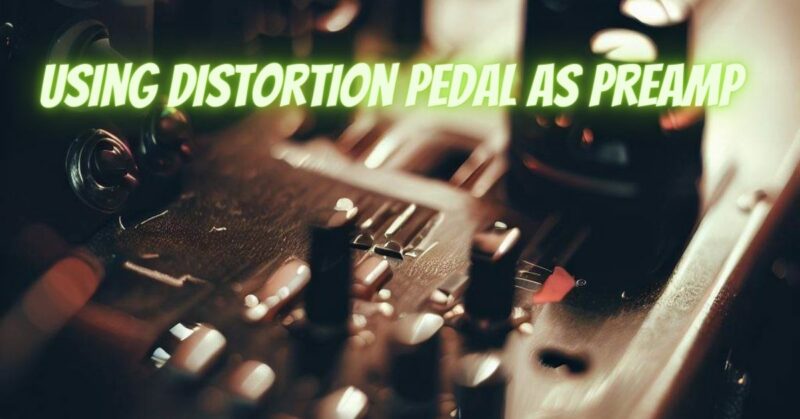A distortion pedal can serve as a versatile preamp, providing additional gain and shaping your guitar tone before it reaches the amplifier. Using a distortion pedal as a preamp can be a creative way to achieve a wide range of tones and expand the capabilities of your rig. In this article, we will discuss how to use a distortion pedal as a preamp effectively.
- Connect the Distortion Pedal: Start by connecting the distortion pedal in your guitar signal chain. Use a standard instrument cable to connect the output of your guitar to the input of the distortion pedal. If you have other pedals in your setup, connect the output of the distortion pedal to the input of the next pedal in line. Finally, connect the output of the last pedal to the input of your amplifier.
- Set the Distortion Pedal Controls: Every distortion pedal has different controls, so it’s important to familiarize yourself with the specific features of your pedal. Common controls found on distortion pedals include gain, tone, level, and sometimes additional options like mid-range or presence controls. Experiment with these controls to shape your desired tone. Start with conservative settings and make adjustments as needed.
- Determine the Amp Setup: Decide how you want to incorporate the distortion pedal into your amp setup. There are a few different approaches you can take:
a. Into the Clean Channel: Connect the output of the distortion pedal to the input of the clean channel on your amplifier. Set the amplifier’s controls to a clean or neutral sound. This allows the distortion pedal to provide the preamp gain and tonal shaping, while the amplifier’s clean channel amplifies the signal.
b. Into the Dirty Channel: If your amplifier has a dedicated overdrive or distortion channel, you can use the distortion pedal as a boost or additional gain stage. Connect the output of the distortion pedal to the input of the dirty channel on your amplifier. Adjust the controls on the distortion pedal and the amplifier to achieve the desired level of distortion.
c. Direct into the Power Amp: Another option is to bypass the preamp section of your amplifier and connect the output of the distortion pedal directly to the power amp input. This approach allows the distortion pedal to act as the primary preamp, shaping the tone and providing the main source of gain.
- Adjust the Amp Settings: Based on your chosen setup, adjust the settings on your amplifier to complement the distortion pedal. If you’re using the pedal into a clean channel, set the amplifier to a clean or neutral sound. If you’re using it into a dirty channel, adjust the amplifier’s gain, tone, and volume controls to blend with the pedal’s sound. If you’re going direct into the power amp, you have more flexibility to shape the overall sound with the pedal alone.
- Experiment and Fine-Tune: Now that your distortion pedal is connected and the amp is set, take the time to experiment and fine-tune your sound. Explore different combinations of pedal settings and amp settings to find the tones that suit your playing style and musical preferences. Adjust the controls on the pedal and the amplifier to achieve the desired level of distortion, tone, and overall sound.
Conclusion:
Using a distortion pedal as a preamp can be an excellent way to shape your tone and expand your tonal possibilities. By connecting the distortion pedal in your guitar signal chain and adjusting the settings on both the pedal and the amplifier, you can achieve a wide range of distorted tones. Experiment with different setups, pedal settings, and amp settings to find the combinations that inspire you. Enjoy the versatility and enhanced tone that using a distortion pedal as a preamp can bring to your playing.


